[ad_1]
Failed transportation network AerialPerspective Works/E+ via Getty Images
There is a race between the deployment of grade-separated urban networks of self-driving vehicles (Mobility As A Service, or “MAAS”) and rising gas prices replaying the 2008 financial crisis. Until such networks substantially cut gasoline demand, The United States Gasoline ETF, LP (NYSEARCA:UGA) will continue to increase.
Law of Supply and Demand
The law of supply and demand will force gas prices higher. UGA ETF is a strong buy until governments fix prices or there is an economic collapse.
Both gasoline and oil inventories are below their 5-year averages (link to EIA crude and gasoline data). Similar inventory issues in July 2008 (link to Seeking Alpha article at that time) resulted in gasoline outages and higher gas prices across the U.S. Southeast in Sept 2008. Below is the current EIA graph of gasoline inventories. EIA’s inventory is “accounting” based. They do not subtract the 190 million barrels of gasoline required to fill the supply chain. So usable inventory is currently ~30 million barrels. If consumers shift from filling their gas tanks “just-in-time” to “just-in-case,” 60 million barrels of supplies will shift from available in distribution to unavailable in gas tanks. With the current inventory outages, much higher gas prices are possible at any time. The hacking of a pipeline, the war in Ukraine, “above-normal” hurricane forecast, and fear add to supply chain risks.
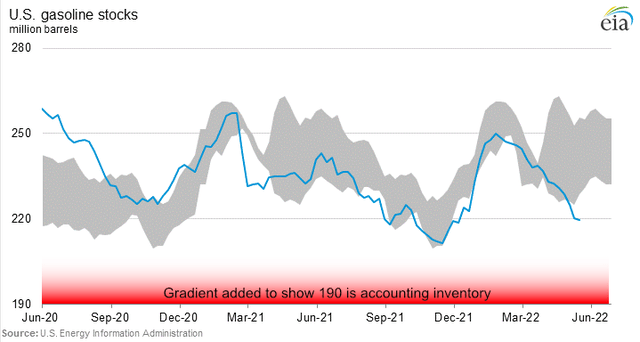
Solution: Efficiencies from Grade-separation/control
Grade-separated networks providing Mobility As A Service radically improve efficiencies and will curb urban demand for oil. The railroads and Morgantown PRT provide examples.
Railroads use grade-control to avoid stop-starts, repetitive applications of power required for acceleration. This results in 470 ton-mpg efficiency that caused Warren Buffett to buy BNSF Railway.
Efficiency gains from grade-separation and self-driving cars were key components of President Nixon’s environmental efforts and response to U.S. Peak Oil in 1970. He sent his daughter Tricia to open the first grade-separated network of self-driving cars in Morgantown, WV in 1972.
The Morgantown PRT has since delivered over 150 million oil-free passenger-miles. Here is a 2013 Letter from the Mayor of Morgantown on the efficacy of the network.
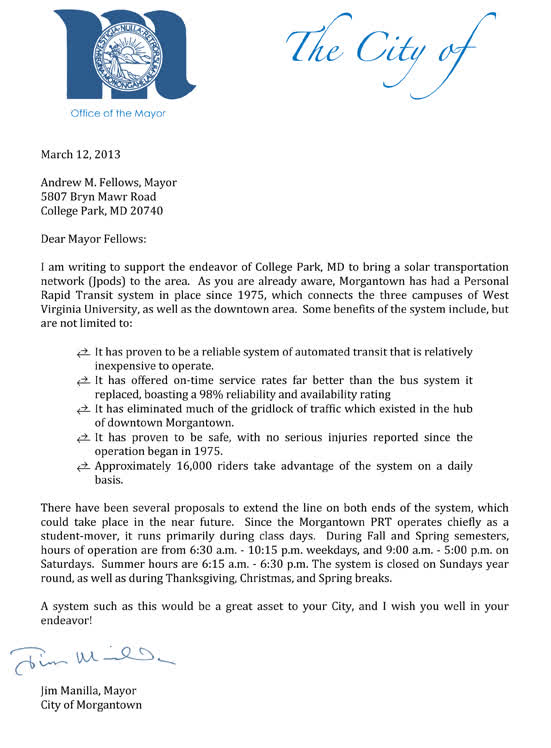
Modern grade-separated networks of self-driving cars are coming:
- Elon Musk has built ~1.7 miles of tunnels in Las Vegas and has initial approval for 29 more miles. The Boring Company recently completed fundraising to build more tunnels.
- Swyft, A group out of Google recently reported signing an agreement in New Zealand.
- In 2021, Praetor Capital published an assessment of the capital value of the small companies in this industry.
- Georgia Mobility Company recently signed an agreement with the Mayor of Macon, GA to begin building the world’s first JPods solar-powered mobility network (disclosure: I am a founder of both Georgia Mobility and JPods. Solar-powered mobility networks of self-driving vehicles is my U.S. Patent).
Urban grade-separated networks of self-driving vehicles have efficiencies approaching railroads. Cost per passenger-mile data for the JPods’ network are used to illustrate the 10X lower operating costs. Mass DOT data is used for buses and trains ($1.45 and $0.76; 50X and 25X). AAA data and U.S. DOT data for cost and passengers per car are used for cars ($0.38; 10X). JPods operating costs are $0.03. Riding in your car on a freight train would cost about $0.01 per mile.
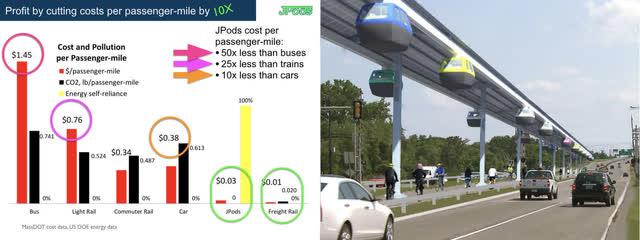
Change in Regulations
The Tesla (TSLA), Swyft, and JPods agreements indicate a century of unconstitutional regulatory barriers being corrected. Three barriers were put in place by Federal monopolies in the early 1900s.
Communications faced similar regulatory barriers until courts forced an end to the Federal communications monopoly in 1982.
Since The Federal-Aid Highway Act of 1916 replaced efficiency with political influence as the deciding factor in making infrastructure decisions, 46% of ~470 ton-mpg railroads have been replaced by roads with the 25-mpg efficiency of the Model-T.
The transportation regulatory barriers for networks of self-driving cars are documented in Congressional Study PB-244854. This study was published in 1975 to identify solutions to the 1973 Oil Embargo:
- Morgantown’s PRT is a solution to end dependence on foreign oil.
- Government “institutional failures” blocked urban transportation innovation for “four to six decades (aside from some relatively minor cosmetic changes)”
The Solar Mobility Agreement in Macon provides a simple 5X5 Standard (link to agreement) that can be repeated in many cities:
- Unless rejected in writing within 30-days from plan submission (preempt bureaucratic delays),
- Privately funded networks 5 times more efficient than roads (metrics versus political influence driving access),
- May use the airspace over roads for 5% of gross transportation revenues (similar to other networks for communications and power).
Massively deploying Mobility As A Service in cities can reduce demand. Currently, only Tesla is traded. As networks are built in Georgia, it is highly like the Georgia Mobility Company LLC will go public.
80-Year Trend and Price Control Risk
Regulatory change that enables demand reduction is the only thing that can impact the 80-year trend in oil prices. Supplies will continue to be more expensive to extract and protect from wars.
Source: EIA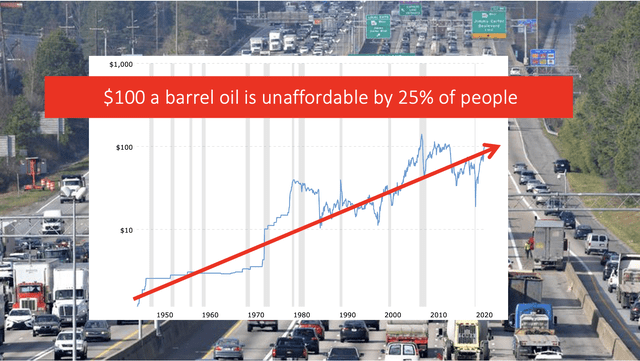
Until such networks are rapidly deploying, UGA will continue to ratchet higher until foreclosures and unemployment repeat a crisis like 2008. This demand reduction has traditionally followed gas price increases by 12-18 months. This unemployment issue is a risk to UGA if governments impose price controls.
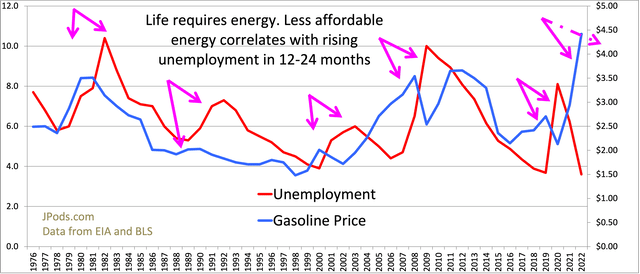
[ad_2]
Source links Google News

